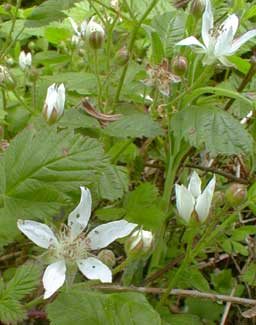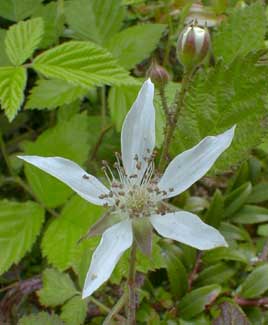
Trailing Pacific Blackberry; aka:
Northwest Dewberry,
California Blackberry,
or Western Blackberry
"May be true what I had heard,
Earth's a howling wilderness
Truculent with fraud & force,"
Said I, strolling through the pastures,
And along the riverside.
Caught among the blackberry vines,
Feeding on the Ethiops sweet,
Pleasant fancies overtook me:
I said, "What influence me preferred
Elect to dreams thus beautiful?"
The vines replied, "And didst thou deem
No wisdom to our berries went?"
-Ralph Waldo Emerson
(1803-1882)
The name Rubus ursinus alludes to these berries' attractiveness to bears. This native little blackberry creeps out of the surrounding woods to invade gardens of Western Washington. It likes to creep around very close to the ground, but in spring it will reach upward for sunlight & climb into shrubs.
 It cohabits naturally with our local evergreen huckleberry, salal, & Pacific rhododendrons. Though this small vine can be pesky, encountering it in extensive areas as the dominant blackberry can be a relief, in places where the invasive 'Himalaya Giant' blackberry has not yet gotten a foothold displacing native flora.
It cohabits naturally with our local evergreen huckleberry, salal, & Pacific rhododendrons. Though this small vine can be pesky, encountering it in extensive areas as the dominant blackberry can be a relief, in places where the invasive 'Himalaya Giant' blackberry has not yet gotten a foothold displacing native flora.Though commonest west of the Cascades & along the coast from northern California to British Columbia, it can also be found as far inland as Idaho & as far south as Baja California. Its tendency to invade gardens that are near woods extends to a fondness for the ground under grape arbors in Northwest vineyards.
Yet being a native plant, it is not really troublesome, is easily managed, & doesn't actually compete with the grapes or orchards even if the trailing blackberry is allowed to go a little rampant. In any typical garden, a heavy pair of gloves is all it takes to restrict it.
Its fragrant flowers are white sometimes with pinkish hues becoming numerous toward the end of April & still everywhere in evidence May & June. These are followed by small sweet berries starting ruby-red & ripening to black in June, July & August.
Although it cannot compete harvest-wise with the 'Himalaya Giant,' whose enormous fruits fill a bucket quickly & are exceedingly sweet, the wilder flavor of jams & preserves from the trailing native has unique charm. As fresh fruit or frozen, the native berries store a bit better than the 'Himalaya Giant' which quickly go all mushy.
In breeding programs this wild blackberry gave rise to the domestic Loganberry, Boysenberry, & Youngberry, which form larger shrubby patches & are better for harvestable fruits, each with its unique flavor & with taste & sizes sometimes greater even than the invasive 'Himalaya Giant.' But it can be a lucky thing to live at a woodland edge where the wild real thing is growing, even if the fruits are smaller & take longer to fill a jar.
Pacific blackberries thrive in a wide range of conditions including in places with seasonal flooding but dry summers, in poor soil or good soil, as undergrowth in shady woodlands & especially bright shade, or out in the open in full sun where they will weave a stickery carpet of vines. Here in Kitsap County they are semi-evergreen, though at higher elevations or further north into British Columbia they are deciduous stickery vines.